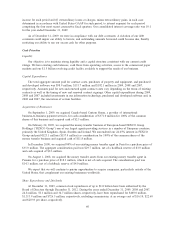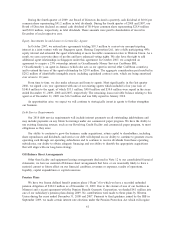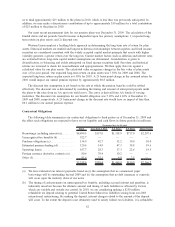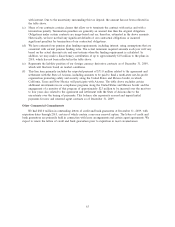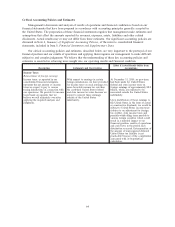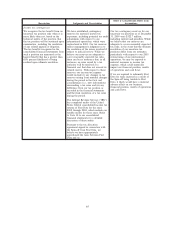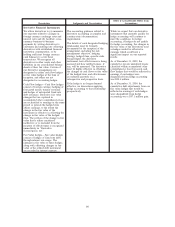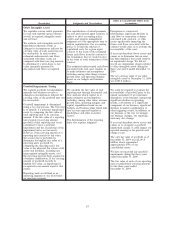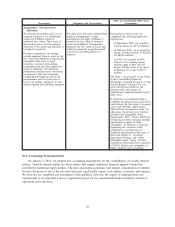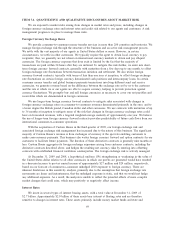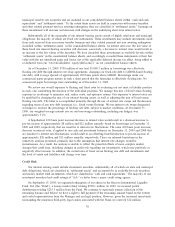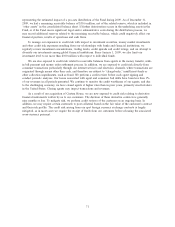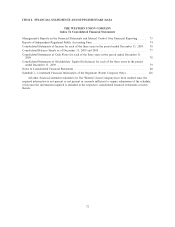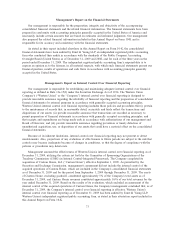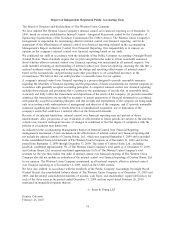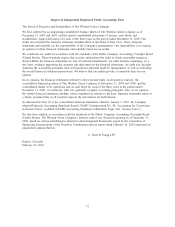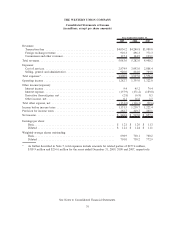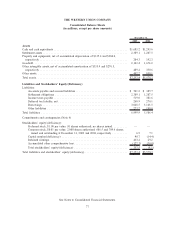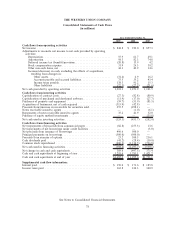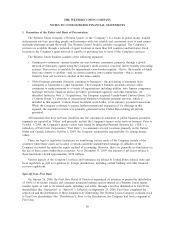Western Union 2009 Annual Report Download - page 84
Download and view the complete annual report
Please find page 84 of the 2009 Western Union annual report below. You can navigate through the pages in the report by either clicking on the pages listed below, or by using the keyword search tool below to find specific information within the annual report.municipal variable rate securities and are included in our consolidated balance sheets within “cash and cash
equivalents” and “settlement assets.” To the extent these assets are held in connection with money transfers
and other related payment services awaiting redemption, they are classified as “settlement assets.” Earnings on
these investments will increase and decrease with changes in the underlying short-term interest rates.
Substantially all of the remainder of our interest bearing assets consist of highly rated state and municipal
obligations, the majority of which are fixed rate instruments. These investments may include investments made
from cash received from our money transfer business and other related payment services awaiting redemption
classified within “settlement assets” in the consolidated balance sheets. As interest rates rise, the fair value of
these fixed rate interest-bearing securities will decrease; conversely, a decrease to interest rates would result in
an increase to the fair values of the securities. We have classified these investments as available-for-sale within
“settlement assets” in the consolidated balance sheets, and accordingly, recorded these instruments at their fair
value with the net unrealized gains and losses, net of the applicable deferred income tax effect, being added to
or deducted from our “total stockholders’ equity/(deficiency)” on our consolidated balance sheets.
As of December 31, 2009, $750 million of our total $3,048.5 million in borrowings was effectively
floating rate debt through interest rate swap agreements, changing our fixed-rate debt to LIBOR-based floating
rate debt, with average spreads of approximately 200 basis points above LIBOR. Borrowings under our
commercial paper program mature in such a short period that the financing is effectively floating rate. No
commercial paper borrowings were outstanding as of December 31, 2009.
We review our overall exposure to floating and fixed rates by evaluating our net asset or liability position
in each, also considering the duration of the individual positions. We manage this mix of fixed versus floating
exposure in an attempt to minimize risk, reduce costs, and optimize returns. Our exposure to interest rates can
be modified by changing the mix of our interest bearing assets, as well as adjusting the mix of fixed versus
floating rate debt. The latter is accomplished primarily through the use of interest rate swaps and the decision
regarding terms of any new debt issuances (i.e., fixed versus floating). We use interest rate swaps designated
as hedges to increase the percentage of floating rate debt, subject to market conditions. At December 31,
2009, our weighted-average interest rate on our borrowings outstanding, including our hedges, was
approximately 5.1%.
A hypothetical 100 basis point increase/decrease in interest rates would result in a decrease/increase to
pre-tax income of approximately $8 million and $12 million annually based on borrowings on December 31,
2009 and 2008, respectively, that are sensitive to interest rate fluctuations. The same 100 basis point increase/
decrease in interest rates, if applied to our cash and investment balances on December 31, 2009 and 2008 that
are sensitive to interest rate fluctuations, would result in an offsetting benefit/reduction to pre-tax income of
approximately $20 million and $13 million annually, respectively. There are inherent limitations in the
sensitivity analysis presented, primarily due to the assumption that interest rate changes would be
instantaneous. As a result, the analysis is unable to reflect the potential effects of more complex market
changes that could arise, including changes in credit risk regarding our investments, which may positively or
negatively affect income. In addition, the current mix of fixed versus floating rate debt and investments and
the level of assets and liabilities will change over time.
Credit Risk
Our interest earning assets include investment securities, substantially all of which are state and municipal
debt obligations, which are classified in “settlement assets” and accounted for as available-for-sale securities,
and money market fund investments, which are classified in “cash and cash equivalents.” The majority of our
investment securities had credit ratings of “AA-” or better from a major credit rating agency.
On September 15, 2008, we requested redemption of our shares in the Reserve International Liquidity
Fund, Ltd. (the “Fund”), a money market fund, totaling $298.1 million. In 2009, we received partial
distributions totaling $255.5 million from the Fund. We continue to vigorously pursue collection of the
remaining balance and believe we have a right to full payment of the remaining amount based on the written
and verbal representations from the Manager and our legal position. However, given the increased uncertainty
surrounding the numerous third-party legal claims associated with the Fund, we reserved $12 million
70


